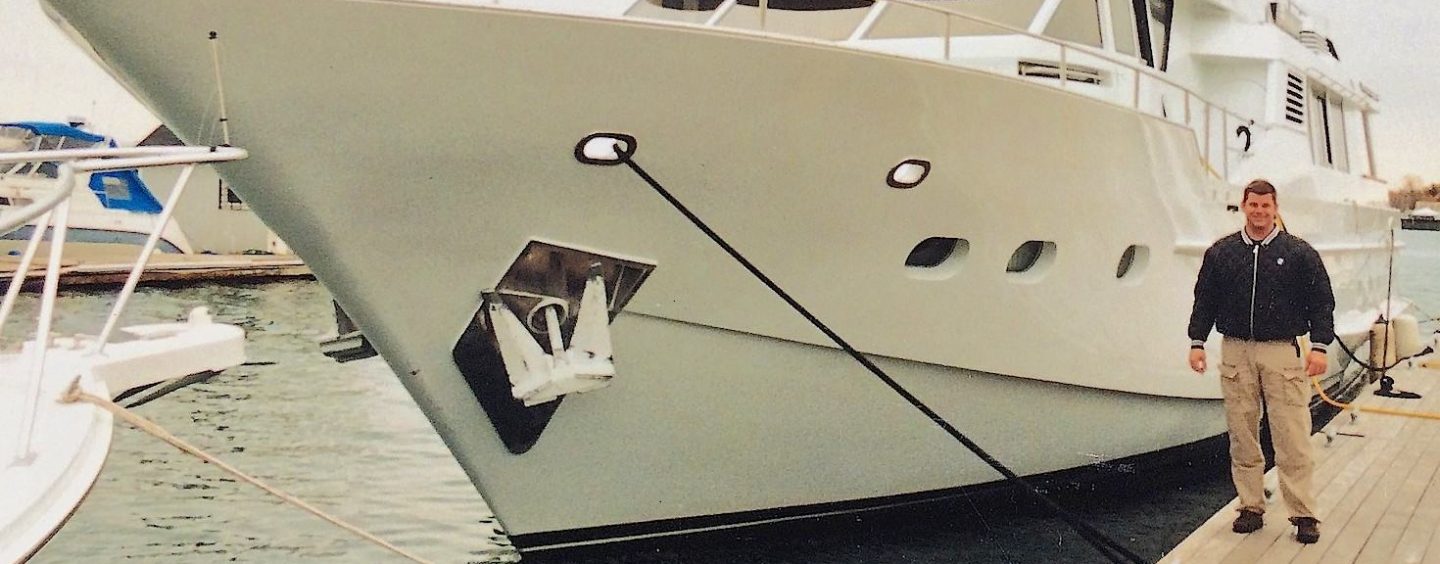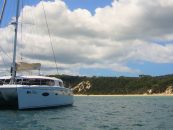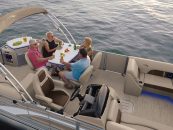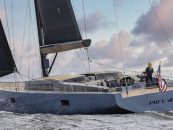There is a point when facing the unknown stops being a longed-for adventure and becomes a terrifying reality. Confronting a storm at sea is one of those terrifying realities for Gold Coast resident ANDY McCUTCHEON.
I answered an online ad seeking delivery crew for a 100’ superyacht from her summer home in the US North Atlantic sea port of Rockland Maine, bound for her home port in Fort Lauderdale, Florida. The Dutch-built motor-yacht just completed a major refit undertaken by her owner, a recent dot-com millionaire who provided the seemingly endless amount of monies being poured into his pride and joy.
He had the vessel lengthened by 10’ as part of the refit and proceeded to retrofit two lazarette lockers on the transom, each with remote-controlled, hydraulically lifted, electronically operated servo-locked doors. It seemed a bit over the top to me, and I’m sure it became a talking point among the gin-and-tonic crowd at the Nassau Yacht Club, stern to at the marina.
While we provisioned the vessel for its 1600nm journey, the owner installed banks of computer screens that would monitor and display the status of systems aboard. He planned to make a straight shot from Rockland, running approximately 30nm offshore to the entrance of the breakwater at Fort Lauderdale.
We departed on a Saturday afternoon at 1500h amid some light drizzle, hand steering the vessel out of a series of inland bays to open water. I was one of three crew on 4-hour watches shared with the owner. My watch was from midnight to 0400h.
As we approached open water, the weather deteriorated. I BBQ’d steaks under the covered aft deck while the boat pitched and rolled, and fed the crew. With the prospect of a long night ahead, I decided to get some sleep.
I woke to my alarm ten minutes before my watch. The weather had worsened while I was asleep, and the hydraulic-driven autopilot was now trying to hold course in 8m seas. The driving rain and increasing wave heights were concerning, but barely palpable from inside the protected bridge-deck, illuminated by LED screens and a single red overhead navigation light. The owner gave strict instructions not to touch anything. We were to monitor the information on the screens, and alert him if an alarm went off.
At 0218h, a wave crashed loudly over the bow sending sea-spray well past the bridge-deck windows as the vessel’s wiper blades struggled to keep up and provide clear vision. In an instant, everything went black. All LED screens went out, the red navigation light went out and our running lights were now off. It took a few moments for my eyes to adjust to the darkness. ‘Our auto-pilot must be offline too,’ I thought, as the vessel was now tracking to starboard into the trough of an approaching wave.
The owner’s strict instructions were ringing in my head – but not nearly as loud as the alarm bells of self-preservation. I frantically grabbed the wheel and steered hard to port. As the vessel came around, I tried maintaining the course heading of 190 degrees, but something was wrong. As I brought the vessel onto 190 degrees, it wouldn’t hold, but instead fell off about 30 degrees to port. I tried again, this time it fell off 30 degrees to starboard. It felt like we had a light bow…or a heavy stern.
I couldn’t leave the bridge-deck. The vessel needed to be gently hand-steered trying to compensate for the unusual course fluctuations, so we didn’t end up abeam in the trough of an 8m wave. When the vessel stabilised, I tried to call the owner, but the cabin phone was dead. The entire vessel was without power.
I shouted repeatedly, and within a few minutes the crew hastened to my call. Thirty minutes into the ordeal, I was surprisingly calm, cool and able to communicate my theories on what had caused the blackout. But I wanted to check something first just to be sure. I momentarily handed over the wheel and took a torch to the aft deck. My worst fears were confirmed. The lazarrette doors were slightly opened and taking on water with every wave.
As I opened the lazarrette doors, which led to a purpose-built storage area for tools and spare parts, it was thrashing around like a giant washing machine and there were thousands of litres of sea water in the boat. We were sinking. At that moment, my fear turned to anger as the owner’s ridiculous ‘must-have’ mechanical ‘geek-gadget’ lazarrette doors had allowed sea water to ingress by way of an electrical fault in his servo-driven locks causing them to unseal.
I hurried back to the bridge-deck. We needed to make an action plan – fast! I did not want to wake the owner up at this point. Given his most recent short-sighted blunder, waking him up may in fact further jeopardize the safety of the vessel.
We managed to find a set of paper charts using the torch. I did some rough calculations using speed, time and distance, and worked out that we were about 35nm from Kennebunkport, Maine, and adjusted our course accordingly to arrive just after dawn at our present speed. By first light, we had navigated past West Goose Rocks and were at the mouth of the Batson River near Marshall Point. The storm had passed. I pulled the vessel into a sheltered cove. We dropped the anchor, shut off the engines, and rested.
The deafening silence of the arrested engines alongside the dawn sunlight was enough to rouse the owner, who made his way to the bridge-deck in a dressing gown, querying why the vessel had stopped. After a comprehensive overview of the night’s events, his curiosity led to a more thorough investigation of the damages. He managed to restore power to the vessels systems, which was an encouraging start. When he emerged, a US Coast Guard vessel was coming alongside, as they were unable to raise us on the radio prior to the power coming back online. They had received an emergency call from a resident high on the Kennebunkport bluff who ‘had seen a large vessel anchored with her stern visibly below the waterline’ and thought they should check us out.
It took six days to remove all the metal and plastic shards that were thrashing around in nearly 15,000L of water contained in the newly added transom extension of the superyacht, caught in the middle of a late autumn nor’easter in the pitch black of night, 30nm offshore.
I learned an invaluable lesson about myself that night. “Stop trying to calm the storm – calm yourself, the storm will pass.”
It is said that, ‘A strong soul shines after every storm.’ I left with a new respect for the sea and for myself. I’m not certain I will ever conquer my fear of storms.






























